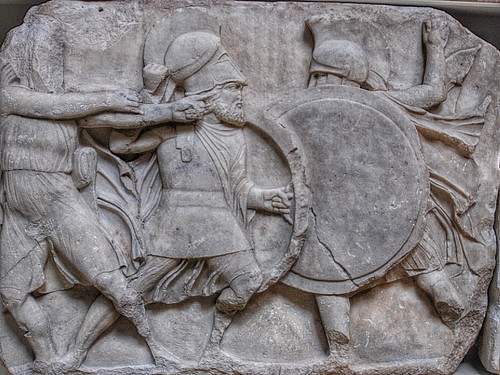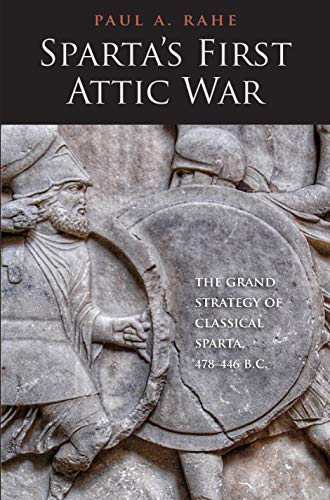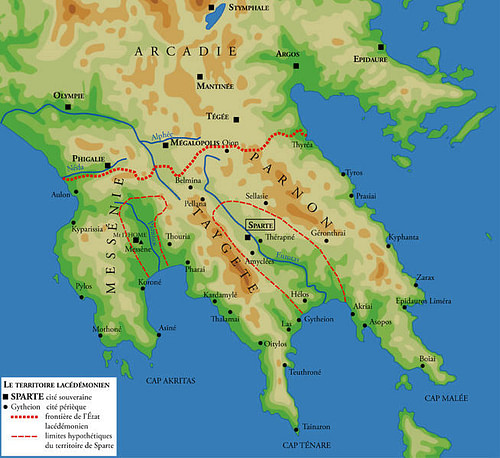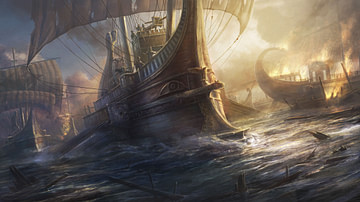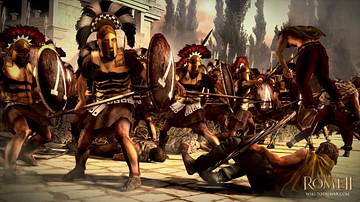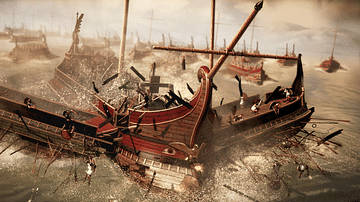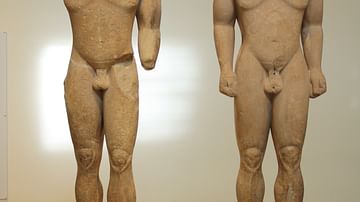In ancient Lacedaemon, as in all enduring political communities, there was a symbiotic relationship between the form of government chosen, the way of life that this form of government fostered, and the grand strategy that the community gradually articulated for the defense of its ruling order and way of life. In the Spartan case, this symbiosis becomes vividly evident if one traces the emergence of the community, its political institutions, and its peculiar practices and then considers the challenges it faced and the manner in which it coped with those challenges. As one would expect, when, in frustration, the Lacedaemonians abandoned the grand strategy they had articulated early on, they dealt a fatal blow to their regime and way of life.
Strategy & Grand Strategy
Just under a century ago, J. C. F. Fuller drew a sharp distinction between "strategy," which was "more particularly concerned with the movement of armed masses," and what he called "grand strategy" – which, he wrote, "including these movements, embraces the motive forces which lie behind them," whether they be "material" or "psychological." As he put it,
The first duty of the grand strategist is . . . to appreciate the commercial and financial position of his country; to discover what its resources and liabilities are. Secondly, he must understand the moral characteristics of his countrymen, their history, peculiarities, social customs and system of government, for all these quantities and qualities form the pillars of the military arch which it is his duty to construct. (211-28)
To this end he added, the grand strategist must be "a student of the permanent characteristics and slowly changing institutions of the nation to which he belongs, and which he is called upon to secure against war and defeat. He must, in fact, be a learned historian and a far-seeing philosopher, as well as a skilful strategist and tactician." He implied as well that the grand strategist needed a similar understanding of the resources, liabilities, history, regime, and way of life of his country's allies and rivals. In consequence, Fuller insisted, "the grand strategist" cannot restrict his purview to matters merely military. He cannot succeed unless he is also "a politician and a diplomatist" (ibid).
Although grand strategists, fully equipped with all of the requisite erudition and qualities, may be few and far between, it can be argued that virtually every political community that has staying power manages over time – usually, by a process of trial and error – not only to articulate a grand strategy suited to the defense of the regime under which it is governed and the way of life to which that regime gives rise but also to develop a strategic culture and an operational code compatible with that strategy. Classical Lacedaemon is a case in point.
Ancient Sparta
The origins of the Spartan regime and the way of life attendant on it are shrouded in legend – and scholars who are interested in the subject have to rely to a considerable degree on educated guesswork. There is, nonetheless, much that is certain – or very nearly so.
Early Lacedaemon was a conquest community dependent on the labor of a servile class, called helots, who belonged to the city, were bound to the land, and functioned as sharecroppers. The Spartans appear first to have settled in the Eurotas valley in the southeastern Peloponnese in the 9th century BCE. In the decades that followed, they extended their control over the entire region; and, by the end of the 7th century BCE they had conquered, reconquered, and added to the helots they exploited the population residing in the Pamisos valley in the southwestern Peloponnese. A formidable mountain range called Taygetus separated these two river valleys; the Messenians who lived along the Pamisos regarded themselves as a people in bondage; and, even more than the “old helots” situated along the Eurotas, they were resentful and prone to rebellion. Together, at the time of the Persian Wars in the 5th century BCE, these two restive servile populations outnumbered Sparta's citizens by a margin of four or five, if not seven, to one.
Although policing the helots was a considerable burden, their subjection was also for the Spartiates a great boon. As a ruling order, this body of men constituted an aristocratic class of peers blessed with leisure and devoted to a common way of life centered on the fostering of certain manly virtues. There was very little that they did alone. Together they made music, they sang, and they danced. Together they worked out, competed in sports, boxed, and wrestled. And together they hunted, dined, cracked jokes, and took their repose. Theirs was a rough-and-tumble world, but it was not devoid of refinement and it was not characterized by an ethos of grim austerity, as some have supposed. Theirs was, in fact, a life of great privilege and pleasure enlivened by a spirit of rivalry as fierce as it was friendly.
The manner in which they mixed music with gymnastics and fellowship with competition caused them to be credited with eudaımonía – the happiness and success that everyone craved – and it made them the envy of Hellas. This gentlemanly modus vivendi had, of course, one precondition – Lacedaemon's continued dominion over the two river valleys in the southern Peloponnese and its brutal subjection of the helots on both sides of the Taygetus – and this the Spartans could not achieve without articulating a grand strategy and developing a strategic culture and an operational code compatible with it.
Grand Strategy of Sparta
The grand strategy that, in the course of the Archaic Period (c. 800-479 BCE), the Lacedaemonians gradually worked out for the defense of this way of life was comprehensive, as successful grand strategies generally are. Of necessity, it had domestic consequences on a considerable scale. Its dictates go a long way towards explaining the Spartans' aversion to commerce; their practice of infanticide; their provision to every citizen of an equal allotment of land and of servants to work it; the city's sumptuary laws; their sharing of slaves, horses, and hounds; their intense piety; the subjection of their male offspring to an elaborate system of education and indoctrination; their use of music and poetry to instill a civic spirit; their practice of pederasty; the rigors and discipline to which they habitually subjected themselves; and, of course, their constant preparation for war.
This grand strategy accounts as well for the articulation over time within Lacedaemon of a mixed regime graced with elaborate balances and checks. To sustain their dominion in the two river valleys and to keep the helots in bondage, the Spartans had to eschew faction; foster among themselves the same opinions, passions, and interests; and employ – above all, in times of strain – procedures, recognized as fair and just, by which to reach a stable political consensus consistent with the dictates of prudence. If Lacedaemon came to be known for eunomía or "good order and lawfulness," it was in large part a consequence of their response to the challenges which that community faced.

The type of combat for which the Spartans trained was also pertinent – for the Greek way of war was peculiar, and it rewarded endurance, close coordination, civic solidarity, and numerical superiority. In the late 8th and the 7th centuries BCE, there was a military revolution that established the primacy of hoplite infantry. The key to this was the introduction of the aspís – a concave shield equipped not only with a bronze armband in the center, called a pórpax, through which the warrior slipped his left arm, but also with a leather cord or handle on or near the shield's right rim, called an antılabḗ, for him to lay hold of with his left hand. This shield left the right half of its bearer's body unprotected and exposed, and it extended beyond him to the left in a fashion of no use to him as a solo performer.
When infantrymen equipped in this fashion were operating on their own – cavalry, light-armed troops, and enemy heavy infantrymen in formation could easily make mincemeat of them; and the same was apt to happen when agile light-armed troops equipped with javelins caught such warriors on terrain unsuited to seeking a decision by way of a tight formation. When, however, men equipped with the aspís were deployed on relatively flat ground as hoplites within a phalanx – in close order and in ranks and files – this peculiar shield made each hoplite a defender of the comrade to his left: for, as Thucydides (c. 460/455 - 399/398 BCE) observes (5.71.1), it covered that man's right side. It is this fact that explains the logic underpinning a statement attributed to the Spartan king Demaratus to the effect that "men don helmets and breastplates for their own sake, but the aspís they take up for the sake of the formation which they and their fellows share" (Plut. Mor. 220a).
Enemies & Allies
Not surprisingly, the grand strategy adopted by the Spartans had serious consequences for Lacedaemon's posture in the intercommunal sphere as well. Given the challenges they faced, the Spartans were never sufficiently numerous; and, even in the best of times, their perch was precarious – for they not only had the helots to contend with. To the northeast, they had in the populous city of Argos a formidable enemy from quite early on.
In response to the dangers attendant on their situation, the Spartans could seek support from the períoıkoı, the subordinate free population that lived in peripheral villages on the outskirts of the Eurotas and Pamisos valleys. The latter were initially no more numerous than were the Spartans themselves, and it was never entirely certain that they could be relied on. They, too, had to be overawed. In the long run, the Spartans could not sustain their way of life if they failed to recruit allies outside their stronghold in the southern Peloponnese. The comparison drawn by a Corinthian leader in the 390s BCE, when the number of Spartiates had dwindled, was apt even in the 6th century BCE when they numbered 8,000-10,000. Rivers really do grow in strength as other streams flow into them, and the like could be said of the Lacedaemonians: "There, in the place where they emerge, they are alone; but as they continue and gather cities under their control, they become more numerous and harder to fight" (Xen. Hell. 4.2.11-12).
It took the Spartans decades to sort out in full the implications of their position. Early on, at least, they tried various expedients and found them wanting. By the middle of the 6th century BCE, however, the ephor Chilon and others had come to recognize that, if their compatriots did not find some way to leverage the manpower of their neighbors, they would themselves someday come a cropper. And so the Spartiates reluctantly abandoned the dream of further expansion and took Chilon's advice that they embrace as a dictate of necessity the virtue of moderation and take as their watchword his slogan "nothing too much."
First, they repositioned themselves as defenders of Arcadian autonomy. Then, they presented themselves to the larger Hellenic world as the scourge of tyranny, the champions of liberty, the friends of oligarchy, and the rightful heirs of Homer's Agamemnon. It was under this banner that they rearranged the affairs of their fellow Peloponnesians to their liking, saw to the construction of a system of carriage roads uniting the peninsula, and founded a grand alliance designed to keep the Argives out, the helots down, and the Arcadians, above all others, in.
Conclusion
Taken as a whole the grand strategy articulated by archaic Lacedaemon was brilliantly designed for the purpose it was intended to serve. It had, however, one potential defect. It required on the Spartans' part a policy of isolationism presupposing that for all practical purposes, under Lacedaemon's hegemony, the Peloponnese was a world unto itself – which, to be fair, it had been for more than half a millennium prior to the time in which this strategy was first formulated. If, however, there ever came a moment when a power equal to or greater than Lacedaemon appeared in force – or even threatened to appear – at or near the entrance to the peninsula, the Spartans would have to rethink this strategy and recast it to meet an unanticipated challenge.
This is precisely what the Lacedaemonians did to splendid effect in 480 and 479 when the Achaemenid Empire – greater in its command of the world's population and resources than any other empire in human history – presented itself on their doorstep. And this is what they gamely struggled to achieve time and again during the Peloponnesian War in the period stretching from 465 to 404 BCE when Athens' maritime hegemony came to threaten their hold on the Peloponnese.
The Spartans' experience with these outside threats eventually persuaded them to jettison the grand strategy articulated under the guidance of Chilon in the mid-6th century BCE and embark on an imperial venture. Its defects notwithstanding, however, their original grand strategy better suited their long-term interests and their deepest aspirations than empire-building. For, as Chilon and those who followed him recognized, their compatriots lacked the manpower required for such an endeavor. They were also temperamentally unsuited to the government of free peoples, and their abandonment of moderation and of Peloponnesian isolationism was bound to subvert their way of life and the astonishing discipline hitherto instilled in them by the regimen under which they lived and sustained by mutual surveillance. In consequence, they proved incapable of sustaining the imperial venture on which they had embarked, and the resistance which that enterprise elicited from their longtime allies eventuated in their being deprived of the dominion in the Pamisos valley that had been the foundation of the wealth and of the leisure requisite for the astonishing martial success that they had so long enjoyed.
